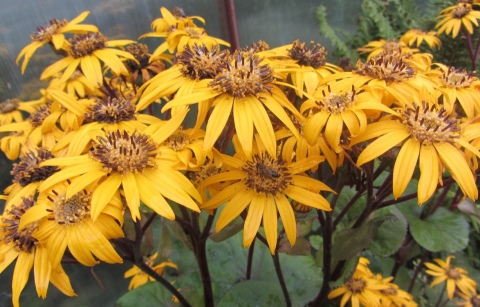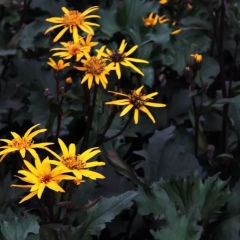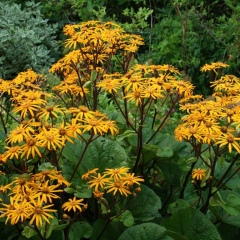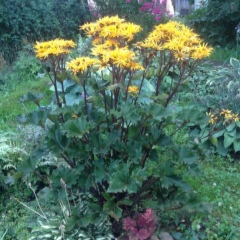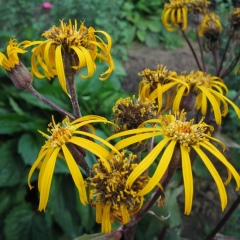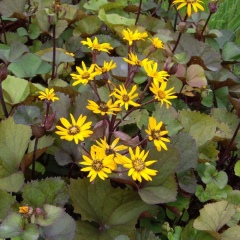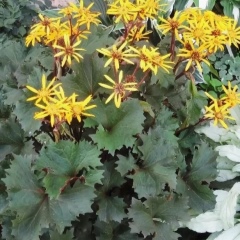Planting site, soil
Buzulnik is an unpretentious plant, but the choice of soil should be approached responsibly in order to get a beautiful flower in the future.
For planting, it is better to choose shaded areas with fairly wet soil. Culture does not like too bright sun, it begins to fade. When landing in dry land, the result will be the same.
Fertile soil with a good amount of nutrients is the best option for such a plant. If the amount of humus in the ground is insufficient, a mixture of garden soil with humus should be added before planting in the pits; ash and superphosphate may be used.
Note! Planting a plant is carried out in two ways - by seeds and seedlings.
Planting from seeds
It is better to plant seeds in the spring when the snow has melted. They are poured into open ground to a depth of about 1 cm. The soil should remain moist until the first shoots appear. Then the seedlings are covered from direct sunlight until they grow up and become stronger.
The best time for planting buzulnik seeds is considered to be late autumn and early winter. In this case, they undergo natural stratification, and the plants from them turn out to be stronger and more powerful.
Buzulnik seeds
Planting seedlings
Sowing seeds for seedlings begins in January and continues until March:
- Holes are made in the container.
- A nutrient drainage about 1 cm high is poured onto the bottom, it is covered with soil, which must be thoroughly moistened.
- Seeds are spread on the surface, sprinkled with earth by 5-7 mm, moistened again.
- The container is covered with foil or glass, and the humidity is monitored.
- When shoots appear after a while, the shelter is removed.
If necessary, small plants are supplemented. After the appearance of two leaves, the flowers can be transplanted into separate containers. Landing in open ground is carried out in May, when the threat of night frosts disappears.
Important! The flowering of a plant obtained from seeds begins only after they reach about 4-5 years. The plant can not be transplanted
Buzulnik feels great in one place for quite a few years. However, experts recommend updating the bushes by dividing every five years. During the flowering period, the transplant cannot be carried out.
The plant does not need to be transplanted. Buzulnik feels great in one place for quite a few years. However, experts recommend updating the bushes by dividing every five years. Transplanting cannot be carried out during the flowering period.
Names and characteristics of species and varieties of buzulnik with a photo
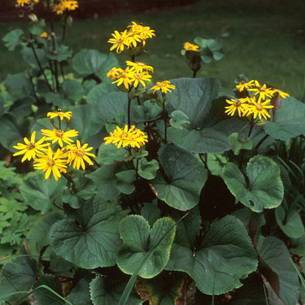
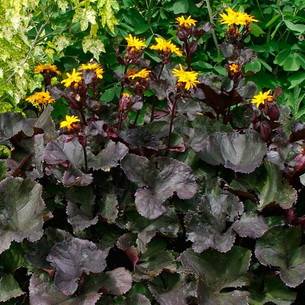
Buzulnik toothed (Ligularia dentata) is a perennial rhizomatous exclusively ornamental plant with straight stems up to 120-180 cm high. Large leaves (up to 50 cm in diameter) are located on long petioles. Flower baskets up to 8 cm in diameter, yellow-brown in color, are collected in a paniculate inflorescence. The marginal flowers of the basket are ligulate, yellow or orange, medial tubular, yellow or brown. Blooms in August - September.
All varieties of toothed buzulnik have inflorescences of different shades of yellow, and they look very bright and elegant. Some of them are described below:

"Othello" - yellow-orange baskets and inflorescences;
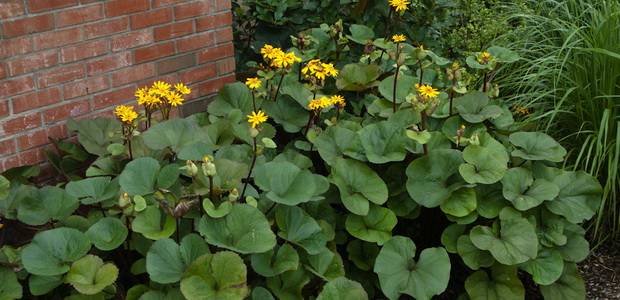
"Desdemona" - bright orange inflorescences and lilac brown leaves;
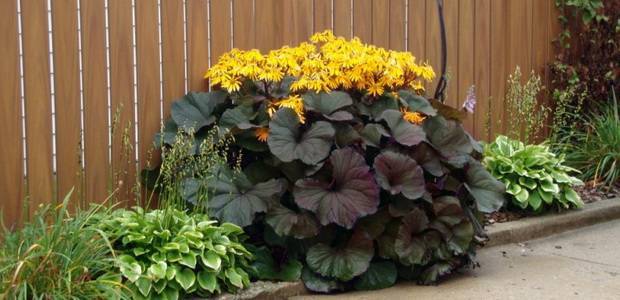
"Britt Marie Crawford" - variety 1 m high. Basal leaves are dark brown above, purple below. The flowers are rich yellow;
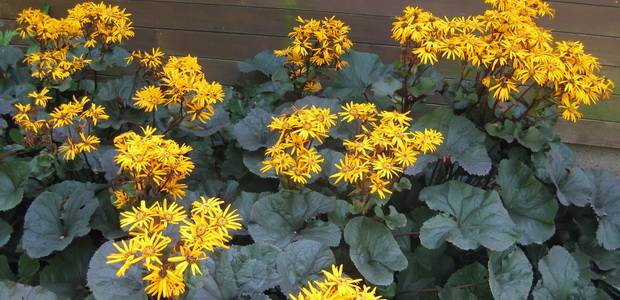
"Orange Queen" - a low-growing variety with a height of about 0.5 cm. Flowers are rich orange color;

Osiris Fantasy is a dwarf variety, reaching no more than 0.5 m in height. The leaf plates are green above, burgundy below.
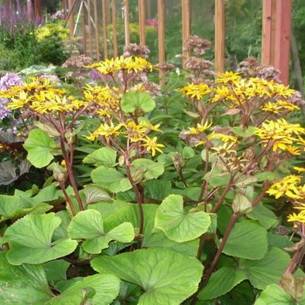
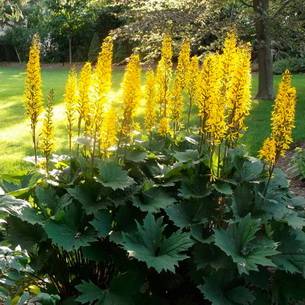
Buzulnik Kempfer (L. kaempferi). Densely leafy plant up to 1.2 m high, serrated leaves, pubescent petioles.Baskets up to 5 cm in diameter, light yellow, collected in corymbose inflorescence.


Buzulnik Przewalski (L. przewalskii). One of the most common types of buzulnik, small bush (up to 90 cm) of a beautiful spherical shape Basal leaves are collected in bunches, stem leaves are lanceolate, on long petioles. Baskets are yellow-brown, up to 4 cm in diameter, collected in a paniculate inflorescence.
Buzulnik Przhevalsky varieties:

"The Rocket" is one of the highest cultivars of buzulnik, the height of which reaches 2 m. The leaves are dark green, in autumn they acquire a crimson color.
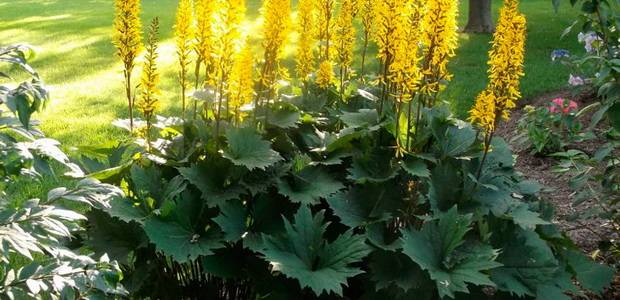
"Maple-leaved" - the variety got its name from the shape of the leaves, reminiscent of maple leaves. They are large, about 25 cm in diameter, dense, rough, dark green. The height of the variety is 180 cm.
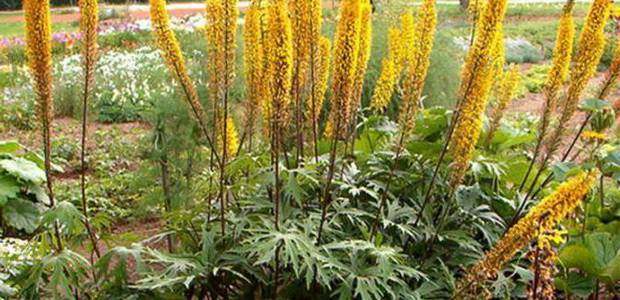
"Light Fingered" - the variety has decorative openwork foliage and bright yellow flowers.
The description of the varieties of buzulnik of this species is supplemented with a photo, which can be seen below and consider the characteristic features of each specimen:
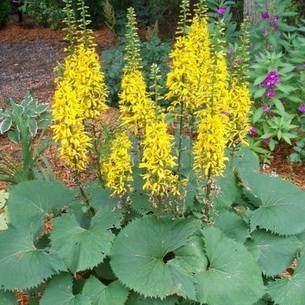
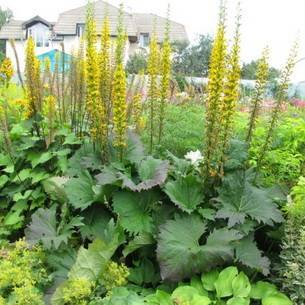
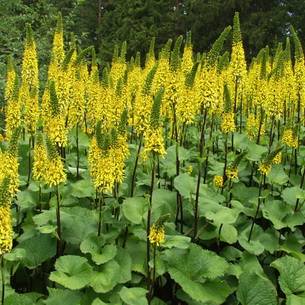
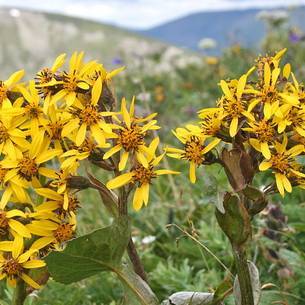
Siberian Buzulnik (Ligularia sibirica). According to its characteristics, it is a perennial short-rhizome plant with an erect stem up to 120 cm in height. The leaves are triangular-cordate, dentate along the edge, the lower ones are on long ones, the upper ones are on short petioles. The leaf blade is glabrous or pubescent on both sides. Baskets 2-3 cm in diameter in racemose inflorescences. Flowers are yellow, marginal ligulate, median tubular. Fruits are achenes with a tuft of simple hairs. Blossoms in June-July; bears fruit in July-August. Occurs in low-lying bogs, boggy meadows, coniferous-small-leaved boggy forests, overgrown peat mining, along the banks of rivers and lakes.

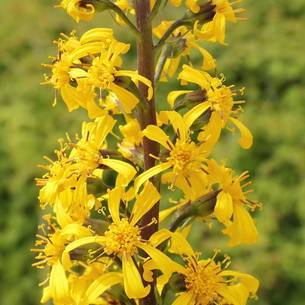
Buzulnik Wilson (Ligularia wilsoniana) is a tall herbaceous plant, reaching up to 1.5 m. It has a thin, straight, branched stem. The leaves are large, dense, rough, dark green. Formed at the bottom of the stem. Flowers are yellow, numerous, collected in inflorescences - baskets with a diameter of 2.5 cm. Flowering begins in July, lasts until late August or early September. This type of buzulnik is distinguished by an increased requirement for lighting; it must be planted in areas open to the sun.
Description of buzulnik: varieties and varieties
Buzulnik (the second name of ligularia) refers to herbaceous perennial plants of the Astrov family. In natural conditions, you can find a flower in Asia and Europe. Buzulnik (ligularia) began to gain popularity only recently, because the plant is unpretentious, blooms for quite a long time and is perennial.
Buzulnik is a perennial plant with bright flowers and original leaves
The flower grows quite tall, can reach 2 meters. It features bright and noticeable colors that will decorate any yard.
Interesting! In total, more than 150 varieties of buzulnik are known, however, no more than 10-15 varieties are used as a garden culture.
The most popular varieties:
- Buzulnik Przewalski;
- Buzulnik narrow-headed;
- Siberian Buzulnik;
- Buzulnik Tunguska;
- Buzulnik Tangut;
- Buzulnik narrow-leaved;
- Buzulnik Vici;
- Buzulnik Wilson;
- Buzulnik toothed;
- Buzulnik Kempfer.
Buzulnik Przewalski is one of the most popular species
Most often in the gardens there are varieties of Przewalski and toothed buzulnik. The first is characterized by a rather high growth and leaf shape. Flowering begins in June. This type includes:
- Light Fingered. Possesses beautiful carved leaves and bright inflorescences.
- Maple-leaved. Differs in beautiful and large leaves, similar to maple.
The maple-leaved buzulnik is distinguished by the original shape of the leaf plates
Buzulnik toothed (Ligularia dentata) differs in smaller growth, more rounded leaves. It begins to bloom at the end of summer, the inflorescences are collected in tassels. Popular varieties:
- Buzulnik Desdemona. Variety desdemona is distinguished by light green leaves on the top and purple or brownish underneath.
- Buzulnik Brit Marie Crawford. Thanks to the leaves of a red hue, it is often used in landscape design.
- Buzulnik toothed Othello. The otello cultivar is distinguished by its orange flowers and the presence of red veins on the leaves.
This type includes the dark beauty buzulnik, the osiris fantasy buzulnik, the pandora buzulnik and the midnight lady buzulnik.
The Buzulnik Little Rocket is considered to be narrow-headed. The variety got its name because of the shape of the peduncles, similar to a rocket. It is able to withstand even very strong winds.
Buzulnik Othello
Varieties differ in their colors, leaves, flowering time and other features. Planting and caring for a buzulnik does not require special conditions, but there are some nuances that you should know before cultivating a plant.
Varieties and types of buzulnik
There are different types and varieties of buzulnik. Let's consider the most popular ones.
| Variety name | general description | Care features | Scope of application |
| Altai (Altaica) | Low bush with short rhizomes, gray leaves, yellow flowers | It does not require special care | As part of flower beds and flower beds |
| Alpine (Alpigena) | Dwarf bush, gray leaves, yellow flowers | Requires periodic watering | Single landing |
| Shiny (Splendens) | Bush up to 1.5 m long, serrated leaves at the edges, yellow flowers | Prefers shade or partial shade | As a background in mixborders |
| Wilson (Wilsoniana) | Bush up to 1.5 m high, wavy leaves, yellow flowers | Requires abundant watering | In group plantings together with large perennials |
| Vorobiev (Vorobievii) | The height of the bush is up to 2 m, the leaves are dark green, the flowers are yellow | Loves moisture, requires watering | In group and single landings |
| Naryn (Narynensis) | Low bush, rounded leaves, yellow flowers | Requires feeding several times during the season | In parks and gardens, in folk medicine |
| Przewalskii | Plant height - up to 1.5 m, dull leaves, yellow flowers; one of the most common types | Unpretentious plant, care is simple | In ornamental gardening |
| Serrated (Dentata) | The height of the bush is up to 1.8 m, the leaves are light green, the flowers are yellow or brownish, a common type | Requires abundant watering | As a tapeworm and as part of groups |
| Kempferi | Bush height - up to 0.5 m, green leaves, yellow flowers | Prefers clay soils, no careful maintenance required | In compositions with rudbeckia and daylilies |
| Chinese (Chinensiana) | Plant height - up to 0.5 m, leaves are cut almost to the middle, green | Loves moisture, especially during dry periods | In flower beds |
| Large-leaved (Macrophylla) | Bush height - 1.5 m, elliptical leaves, gray-gray, yellow flowers | Unpretentious plant, does not require careful maintenance | Single planting and on the lawn |
| Narrow-headed (Stenocephala). | The height of the bush is 1.5 m, the edges of the leaves are serrated, the inflorescences are racemose | Requires feeding several times per season | Can be planted in mixborders as an accent |
| Fischer | Bush up to 1.5 m high, short roots, yellow flowers | Unpretentious appearance, practically does not require maintenance | Looks organically on the shore of the pond |
| Hodgesonii | Dwarf bush, height - 0.45 m, rounded leaves, yellow flowers | Unpretentious, winter-hardy look, grows well in the shade, does not require careful maintenance |
Under trees, near bodies of water |
| Japanese (Japonica) | Shrub up to 1.5 m high, orange flowers, palmate-lobed leaves | Unpretentious variety. But it cannot be planted in direct sunlight. | In the background of the flower garden |
| Hybride | Bush up to 1.5 m high, green or red leaves, yellow-brown flowers | Requires as much moisture as possible | As a tapeworm |
| Zepter | Bush up to 1.5 m high, leaves are carved at the edges, yellow flowers | Garter needed | Looks great among greenery |
| Hessei | Leaves are heart-shaped, flowers are collected in a corymbose inflorescence | Requires feeding as humus | In landings with volzhanki and brunners |
| Finger-lobed (Palmatiloba) | Hybrid, height up to 1.8 cm, rounded leaves, yellow flowers | Undemanding appearance | Together with primrose and tulips |
| Otello | Bush height - 0.9 m, purple leaves, orange flowers | Requires 1-2 feeding with organic substances | For decorating ponds and hedges |
| Desdemona | Possesses lilac leaves; orange flowers, stem height - 1 meter | Poor soils require mineral fertilizing | On the lawn or flower bed |
| Osiris Fantasy | Dwarf bush - up to 0.5 m, the leaves are burgundy on top, dark green below | Periodic watering is required | As a background for a flower garden |
| Britt Marie Crawford (Ligularia dentate Britt-Marie Crawford) | Elegant bush with bicolor leaves, yellow or orange flowers | Requires abundant watering in spring and summer, demanding light |
Near reservoirs of various types |
| Rocket (Stenocephala Rocket) | Powerful tall variety, large leaves, yellow flowers | Virtually no maintenance requirements. Shelter is needed for the winter | Single landing |
Reproduction of buzulnik
There are two ways to propagate the buzulnik: by seeds or by dividing the bush. I would like to immediately warn you that the process of seed reproduction is very laborious, unreliable, long:
- seeds do not always ripen;
- varieties with purple leaves differ poorly;
- in addition, it is not known whether the seedlings will retain varietal characteristics (if the seeds are collected from a hybrid plant, it is already clear here: there will be no varietal characteristics);
- we will see flowering plants in the fifth year;
- Buzulnik is able to reproduce by self-seeding, in the spring, small seedlings appear near the mother bush, which, if desired, can be used.
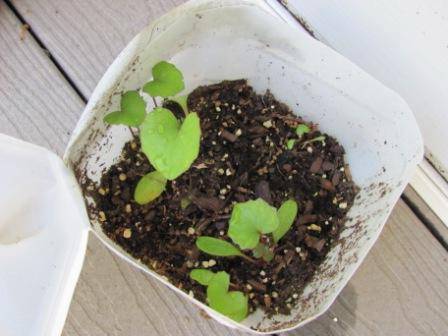
Growing buzulnik ligularia from seeds photo seedlings
If you think you can handle it, then go for it:
- You need to collect the seeds, dry them thoroughly.
- Embed the seeds into the soil 1 cm deep in the fall, so that the planting material undergoes natural stratification. Wait for a persistent cold snap so that the seeds do not germinate until spring. Pour generously, because many of them will not rise. It is imperative to cover the plot with sowing for the winter - to protect the seeds from freezing.
- In the spring, remove the shelter, then wait for the first shoots. The sprouts that have appeared must be shaded, opening only in the morning and in the evening.
- It is necessary to thin out the seedlings twice, with an interval of two weeks. Next, take care of the usual seedlings.
- It is advisable to transplant to a permanent place in the fall, after the extreme heat recession, but so that there is a month or two in reserve until the seedling is completely rooted before wintering.
- The first 3-4 years, young plants will delight us with juicy foliage, usually bloom in the fifth year.
To grow seedlings on a windowsill:
- Place the soaked seeds in a damp cloth and bag in the refrigerator around January.
- In early March, plant them in a moist substrate.
- Cover containers with plastic or glass.
- When shoots appear, remove the shelter.
- Take care in the usual way: water, fertilize once every two weeks.
- It is better not to make a pick, but to break through the extra seedlings, choosing the strongest plants.
- Having hardened the seedlings before planting, we move them to a permanent place around August, when there will be no heat anymore, so that the plants have time to root before wintering.
Reproduction by dividing the bush
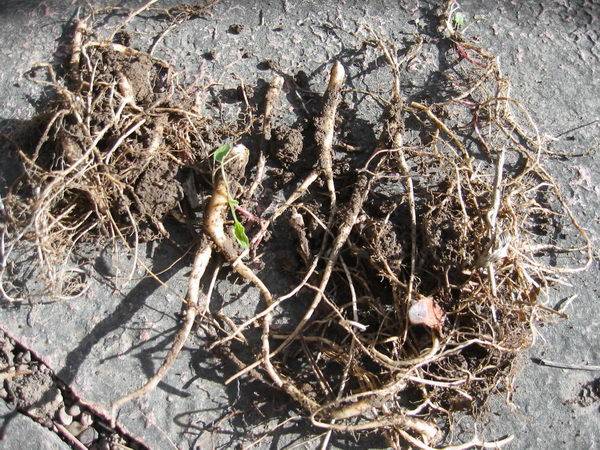
Reproduction of buzulnik by dividing the bush photo
Basically, amateurs do not have so much patience or time, and why, if the buzulnik reproduces perfectly by dividing the bush. In the spring, when the first leaves peck out of the ground, we simply cut off a part of the bush with a shovel and dig it out. The rest of the plant continues to live in its place, quickly healing the wound with nutritious soil, which we will carefully add to the vacant place.
- The extracted planting material must be carefully washed, cleaned, and can be divided into several divisions so that each one has buds and rhizomes.
- To prevent rotting, treat the sections with a strong solution of potassium permanganate, then safely plant them in a permanent place.
- Within a year, the bush will bloom in all its glory.
Buzulnik can grow in one place for many years, however, it is advisable to divide the bush every five years, otherwise the roots will begin to stick out. Since such a procedure is useful for the plant, then you can easily not only buy planting material in specialized stores, but also take the variety you like from your neighbor.
When buying in spontaneous markets, there is a risk that you will buy a completely different plant that you wanted, so to speak "pig in a poke".
In nurseries or flower shops they will tell you everything about the variety of the plant, the age of the seedling. In any case, before planting, carefully examine the seedling so that it is healthy, without signs of disease.
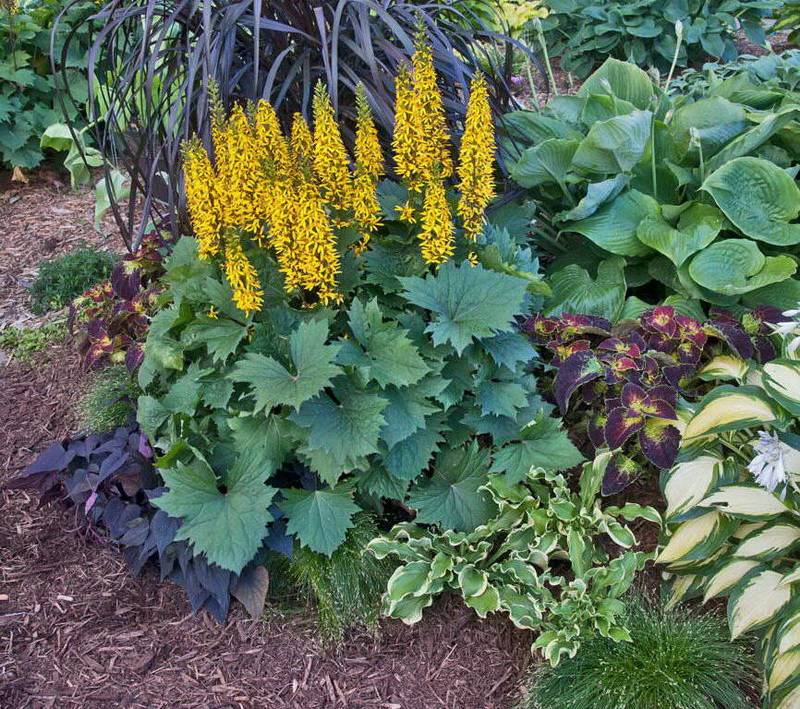
Buzulnik matches very nicely with hosts of different colors
It is important to know the planting site in advance in order to choose the right variety, because some of them are very tall, large, you need to calculate the dimensions correctly, so to speak. Buzulnik will grow on any soil, but prefers fertile, moist soils. His favorite places:
His favorite places:
- the shade of fruit trees;
- partial shade from the fence;
- shadow from the house;
- coolness near ponds, fountains;
- if you have to grow in the sun, it requires abundant and regular watering, otherwise it will lose its decorative appeal.
A bit of history
There is a legend that beautifully tells about the appearance of graceful and unusual irises on earth. One day the rainbow did not disappear, as it usually happens, but shattered into colored fragments. Falling to the ground, its pieces turned into multi-colored variegated irises.

In the Land of the Rising Sun, this flower is treated with the greatest respect. Large-scale festivities dedicated to irises are held here. One of them is called Cebu no sekku, or Boys' Festival, and is celebrated on May 5th. At this time, there is a ritual contemplation of these flowers in the gardens. In the Japanese language there is a separate word for this process - "hanami".
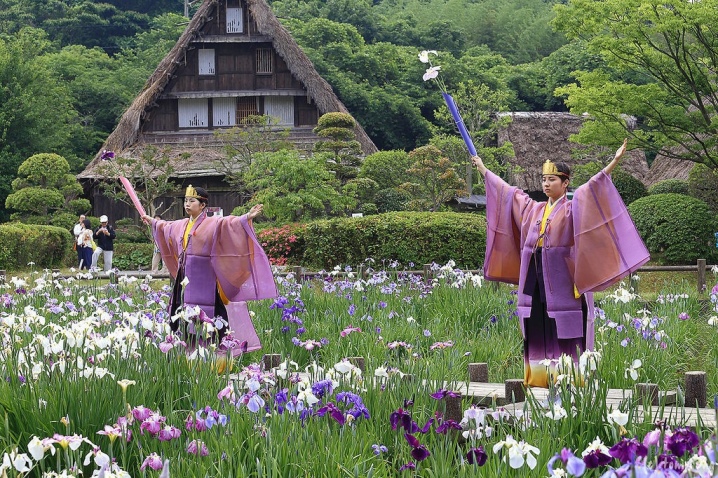
Because the narrow leaves of the iris look like sharp blades, the Japanese associate them with samurai swords. By the way, in the language of this country, the words "iris" and "military spirit" are spelled the same way.
The roots of flowers are used by the Japanese in the production of perfumes, exquisite alcoholic beverages and sweets.


Reproduction methods
Growing from seeds
For sowing levizia, only freshly harvested seed material is used, since it very quickly loses its germination. Dig up an area in the garden in advance and sow the seeds in late autumn. Then cover the surface of the bed with a thick layer of mulch (compost or peat).
The first seedlings should appear in the last days of March or the first ones in April. There are two ways to further grow seedlings:
- Grown seedlings should be cut down.
- Young plants are not touched throughout the year. The next spring, they are immediately transferred to their permanent place.
You can also grow levisia through seedlings. One month before sowing, the seed is placed on a refrigerator shelf. Sowing in boxes is carried out in the spring.
You can do it differently. Small containers are filled with loose, moist soil mixture, then levizia is sown. The seeds are covered with a thin layer of soil. The container is covered with glass from above. They put him in a cold place for a month. And after the first shoots appear on it, the container is rearranged to heat. Wait for the seedlings to form 2 or 3 true leaf plates.
Planting seedlings in the garden is carried out only when the threat of recurrent spring frosts has passed. A bush grown from a seed for the first time will please the gardener with flowers only in the second or third year of growth.
Levisia from seed, my new houseplants
Cuttings
In an adult plant, as it grows, lateral rosettes are formed, which do not have their own root system.If necessary, in the spring, use a sharp knife to separate the outlet and plant it in poor soil in a not very large container. When 2 hours remain before planting the cutting, it is treated with a fungicidal preparation and an agent that stimulates root growth. Place the planted cuttings in a cool place where they should take root after a while. After the root system grows and gets stronger, the bushes can be planted in a permanent place.

